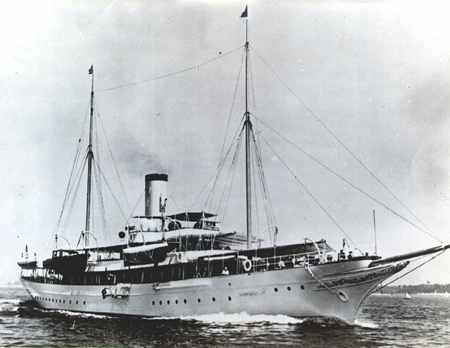USS Cythera (PY 26)
American Patrol yacht

| Name | USS Cythera (PY 26) | ||
| Type: | Patrol yacht | ||
| Tonnage | 602 tons | ||
| Completed | 1906 - Ramage & Ferguson Ltd, Leith | ||
| Owner | United States Navy | ||
| Homeport | |||
| Date of attack | 2 May 1942 | Nationality: | |
| Fate | Sunk by U-402 (Siegfried Freiherr von Forstner) | ||
| Position | 33° 15'N, 75° 26'W - Grid DC 1591 | ||
| Complement | 71 (69 dead and 2 survivors). | ||
| Convoy | |||
| Route | Norfolk - Cristobal - Pearl Harbor | ||
| Cargo | |||
| History | Completed as motor yacht Agawa. In October 1917 leased by the US Navy and commissioned as patrol yacht USS Cythera (SP 575). 1918 based in Gibraltar for escort duties in the Mediterranean. Returned to the owner in March 1919. On 31 Dec 1941 bought by the US Navy for $1 from Edith H. Harkness, New York. Converted to the patrol yacht USS Cythera (PY 26) and commissioned on 3 Mar 1942. | ||
| Notes on event | USS Cythera (PY 26), a small, wooden hull, converted yacht, was refitted in the Philadelphia Naval Ship Yard between December 1941 and March 1942. She was armed with two 3in deck guns, four .50cal machine guns, 50 depth charges and had a complement of five officers and 66 enlisted men. She was commanded by Cmdr Charles Rudderow, a US Navy veteran of WW1. Cythera was 212 feet in length and had a 28 foot beam. Around midnight on 1 May 1942, USS Cythera (Cmdr C. Rudderow, USN) embarked from the US Navy Base in Norfolk, Virginia, enroute to Pearl Harbor, via Cristobal, Panama Canal Zone. She was at sea only 24 hours, traveling south on a zigzag course, when she was attacked at 06.41 hours on 2 May by U-402 approximately 115 miles east of Cape Fear, North Carolina. The U-boat stalked the patrol vessel for at least two hours and finally submerged for an underwater attack, when Von Forstner fired three torpedoes in a fan shaped pattern. The first torpedo passed directly under the bow, the second passed under the stern, but the third struck USS Cythera dead center. The ship immediately split in two, and the forward half rose steeply out of the water. The ship sank very quickly and at least two of her depth charges that were preset exploded underwater. This information was told to me by one of the two survivors, Mr. James M. Brown, who I located in Maine in 1991. He was on forward lookout at the time of the attack. The other survivor was Charles H. Carter, but I was never able to locate him. He was standing on the bridge next to the Commander when they were attacked. As a side note, Charles H. Carter was at Pearl Harbor aboard the battleship USS Oklahoma (BB 37) that was sunk during the Japanese attack. He survived two attacks within 5 months when the ships he was aboard were sunk - incredible! Shortly after USS Cythera went down, U-402 surfaced and turned on its search light looking at whatever debris was floating in the large oil slick that was all that remained from the ship. Brown and Carter were found clinging to a small raft and were taken aboard as prisoners. They asked to be left back in the water but Von Forstner replied: No, boys, the war´s over for you. Both survivors were covered in oil, and Von Forstner gave his sweater to Mr. Brown. Both were also given some brandy to drink. Brown also spoke fluent German, but I never thought to ask if he revealed that to Von Forstner. He did say, however, that the Chief Engineer on the U-Boat spoke fluent English, so I suppose that´s how they communicated. When Brown asked Von Forstner why they were not machine-gunned in the water, Von Forstner and crew members present expressed shock that the Americans would even think of such a thing. During the return trip to France the Americans were treated well. They were given cigarettes every day and allowed to go topside for fresh air every day. Brown said Von Forstner was a compassionate man who was not signed on to Nazi ideology. He was a professional sailor who came from a family of military background. He was not enthusiastic about war, but he did his job well as a German officer. When the Americans were turned over to the German Army in France there apparently was consternation between the U-Boat crew and the German soldiers, who may have manhandled the POWs. In the almost three week trip to France, the crew and prisoners formed somewhat of a bond between them; in fact, the Americans even invited the crew to visit them in America after the war. Brown, at least, wound up in a POW camp in Upper Silezia, Poland for the remainder of the war. The camp produced synthetic fuel and held mostly British POWs. Later in the war, the camp was abandoned because of advancing Soviet forces approaching from the east, and the POWs were force-marched toward Moosburg, Germany, to another camp. He was finally liberated in late April 1945 by forward units of Patton´s 3rd Army and made his way back across Europe where he was put in a military hospital for several weeks. Text compiled by Mr. Mike McCarthy. | ||
| On board | We have details of 70 people who were on board. | ||
If you can help us with any additional information on this vessel then please contact us.
